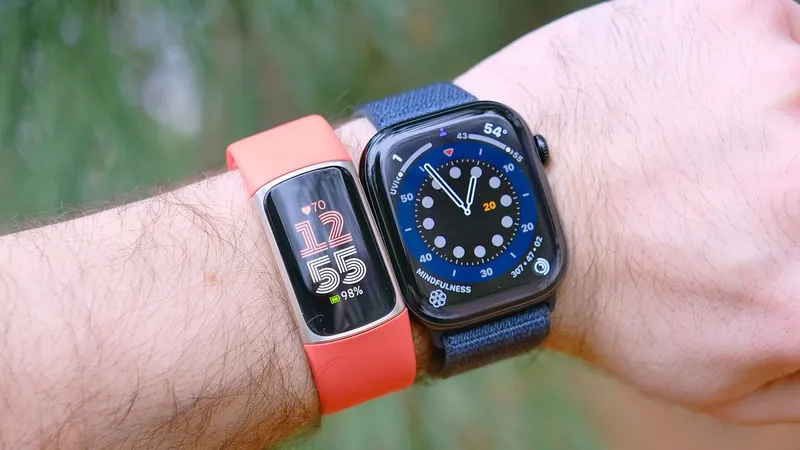
KMFDM: The Industrial Rock Band Misunderstood Amid America’s School Shooting Crisis
2024-12-21
Author: Noah
When one thinks of industrial rock, the chaotic fusion of searing guitar riffs, primal drums, and intricate electronic textures come to mind; all dancing to the beat of impassioned vocals. This sonic storm characterized by raw human aggression has been artistically mastered by the German band KMFDM, a group rooted in messages of individuality and rebellion against systemic injustices.
However, the band's impactful music took an unfortunate turn in 1999, when its lyrics were linked to the perpetrators of the Columbine High School tragedy in Colorado, leading to 13 fatalities. This association starkly overshadowed KMFDM's long-standing advocacy against violence.
Fast forward to January 2023, KMFDM found itself in the headlines yet again after a TikTok video showcased one of their songs just moments before a 17-year-old gunman opened fire at Perry High School in Iowa, resulting in multiple casualties. The narrative intensified with the recent fatal shooting at a private school in Madison, Wisconsin, perpetrated by 15-year-old Natalie Rupnow, who was photographed wearing a KMFDM shirt while at a shooting range.
KMFDM’s Stand Against Violence
In the wake of these tragedies, KMFDM publicly reaffirmed its belief that their music is a statement against violence. "KMFDM are an art form—not a political party," the band stated in its initial response to the Columbine massacre. They expressed sympathy for the victims, reiterating that their music champions themes of anti-war and anti-fascism.
"This situation has been distressing for us, reminding us of how unfairly KMFDM was labeled in the media post-Columbine," the band conveyed to CNN. They emphasized that Rupnow's choice of apparel was more a nod to the tragic legacy of the Columbine shooters rather than genuine fandom. Unfortunately, associations with such violence have cast a long shadow over the band's reputation, as KMFDM lamented the existing subculture that glorifies mass shootings.
The band redirected attention to a critical concern: the pervasive culture of gun violence in the United States. A staggering rise in gun-related deaths and mass shootings has profoundly affected schools, claiming the lives of numerous children and educators. "In a culture obsessed with firearms," KMFDM remarked, "the tendency is to point fingers at other influences rather than addressing the evident issues surrounding access to guns."
The Evolution of Industrial Rock
Industrial music began its journey in the 1970s, primarily in regions like northern England and Germany. It was originally characterized by its experimental sounds—blending abstract noise with musical structures. KMFDM emerged in 1984, initially as a performance art project, with a name that translates to "No pity for the majority," reflecting its Dada-inspired roots resisting nationalism and war.
As industrial music morphed through the late '80s and '90s into a more accessible genre, KMFDM, along with contemporaries like Nine Inch Nails and Ministry, brought industrial rock into mainstream recognition. Their music often explored complex themes of power dynamics and societal violence through a collection of electronic instruments and aggressive rock elements.
Clara Latham, an assistant professor of music technology, notes that this juxtaposition creates a unique aesthetic that mirrors both oppressive qualities and anti-authoritarian messages prevalent in the genre. "The sound reflects the struggle against established norms, resonating powerfully with listeners," Latham stated.
Misinterpretations and Tragic Associations
While the specific motivations of individuals like Rupnow remain ambiguous, experts caution against hastily linking musical choices to violent behavior. Neuroscientist Indre Viskontas pointed out that heightened emotions often drive people to seek music as an outlet, rather than an incitement to violence.
Similarly, Alexander Reed, an industrial music historian, indicated the dangers of misinterpretation. He pointed out specific instances where artists were misappropriated by groups completely contrary to their messages, noting that KMFDM’s lyrics consistently critique societal violence rather than endorse it.
The grim reality is that gun violence, rather than musical influences, is at the center of the ongoing school shooting crisis. As of December 2023, there have been at least 83 school shootings in the U.S.—a chilling reflection of the urgent need for discourse about gun control and the cultural factors leading to violence.
Conclusion: The Real Issue
As KMFDM continues its journey, with a 40th anniversary tour celebrated in 2023, the band remains a stalwart voice amid a troubling cultural landscape. They urge a reassessment of the narratives that so often scapegoat art and music in the face of societal ills. The crux of the matter remains—art may evoke feelings and provoke thought, but it is the culture surrounding firearms that is at the heart of America's school shooting epidemic. As KMFDM aptly summarizes, 'The problem is not with the music; it's the guns.'









 Brasil (PT)
Brasil (PT)
 Canada (EN)
Canada (EN)
 Chile (ES)
Chile (ES)
 España (ES)
España (ES)
 France (FR)
France (FR)
 Hong Kong (EN)
Hong Kong (EN)
 Italia (IT)
Italia (IT)
 日本 (JA)
日本 (JA)
 Magyarország (HU)
Magyarország (HU)
 Norge (NO)
Norge (NO)
 Polska (PL)
Polska (PL)
 Schweiz (DE)
Schweiz (DE)
 Singapore (EN)
Singapore (EN)
 Sverige (SV)
Sverige (SV)
 Suomi (FI)
Suomi (FI)
 Türkiye (TR)
Türkiye (TR)